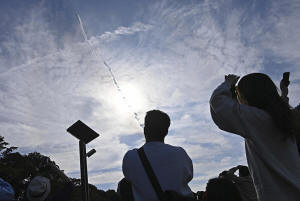Japan successfully launches next-generation H3 rocket after failure last
year
 Send a link to a friend
Send a link to a friend
 [February 17, 2024]
By Kantaro Komiya [February 17, 2024]
By Kantaro Komiya
TOKYO (Reuters) -Japan successfully launched its new H3 flagship rocket
on Saturday, putting its space program back on track after multiple
setbacks including the failure of the rocket's inaugural flight last
year.
The launch also marks a second straight win for the Japan Aerospace
Exploration Agency (JAXA) after its lunar lander, SLIM, achieved a
"pinpoint" touchdown last month and made Japan only the fifth country to
put a spacecraft on the moon.
A relatively small player in space by number of launches, Japan is
seeking to revitalize its program as it partners with ally the United
States to counter China.
The H3 lifted off at 9:22 a.m. local time (0022 GMT) and after it
successfully released a small satellite, jubilant scientists at the
Tanegashima Space Center in southern Japan clapped, yelled and hugged
each other.
The rocket also released a microsatellite and a dummy satellite during
its flight of nearly two hours.
"The newborn H3 has just made its first cry", JAXA project manager
Masashi Okada, who has led the decade-long development of the new
rocket, told a news conference.
"And we need to start preparing for the third H3 launch as soon as
tomorrow."

The H3 is due to replace the two-decade-old H-IIA, which is retiring
after two more launches. Another failed flight would have seen Japan
face the prospect of losing independent access to space.
The first launch in March ended up with ground control destroying the
rocket 14 minutes after liftoff when the second-stage engine failed to
ignite. JAXA listed three possible electrical faults in a review
released in October but could not identify the direct cause.
Five months earlier, JAXA's small rocket Epsilon had also failed to
launch.
"So happy to see this incredible accomplishment in the space sector that
follows on from the success of the SLIM moon landing," Prime Minister
Fumio Kishida said in a post on X.
The 63 m (297 ft) H3 is designed to carry a 6.5 metric ton payload and
over the long-term, the agency wants to reduce per-launch cost to as low
as five billion yen ($33 million) - half of what an H-IIA launch costs -
by adopting simpler structures and automotive-grade electronics.
[to top of second column]
|

A second test model of H3 rocket rises into the air after blasting
off from the launching pad at Tanegashima Space Center while people
look on, on the southwestern island of Tanegashima, Kagoshima
Prefecture, Japan February 17, 2024, in this photo taken by Kyodo.
Mandatory credit Kyodo via REUTERS

JAXA and primary contractor Mitsubishi Heavy Industries hope those
features will help them win launch orders from global clients.
"It's taken some time for the program to get to this point but with
this launch, they will be fielding inquiries from around the world,"
said Ko Ogasawara, a professor at the Tokyo University of Science.
The Japanese government plans to launch about 20 satellites and
probes with H3 rockets by 2030 for domestic use. The H3 is scheduled
to deliver a lunar explorer for the joint Japan-India LUPEX project
in 2025 as well as cargo spacecraft for the U.S.-led Artemis moon
exploration program in the future.
Satellite launch demands have skyrocketed thanks to the rise of
affordable commercial vehicles such as SpaceX's reusable Falcon 9
and a number of new rockets are being tested this year.
Last month marked the successful inaugural flight of the United
Launch Alliance’s Vulcan rocket, a joint venture between Boeing and
Lockheed Martin. The European Space Agency also plans to launch its
lower-cost Ariane 6 for the first time this year.
Masayuki Eguchi, the head of Mitsubishi Heavy's defense and space
business, said the company has a long-term target of launching eight
to ten rockets a year, which would boost its 50 billion yen space
business sales by 20-30%.
That would require additional production capacity, he added, noting
the company's factories can currently only produce five to six H3
rockets a year.
($1 = 150.2100 yen)
(Reporting by Kantaro Komiya; Editing by Edwina Gibbs)
[© 2024 Thomson Reuters. All rights reserved.]This material
may not be published, broadcast, rewritten or redistributed.
Thompson Reuters is solely responsible for this content.
 |